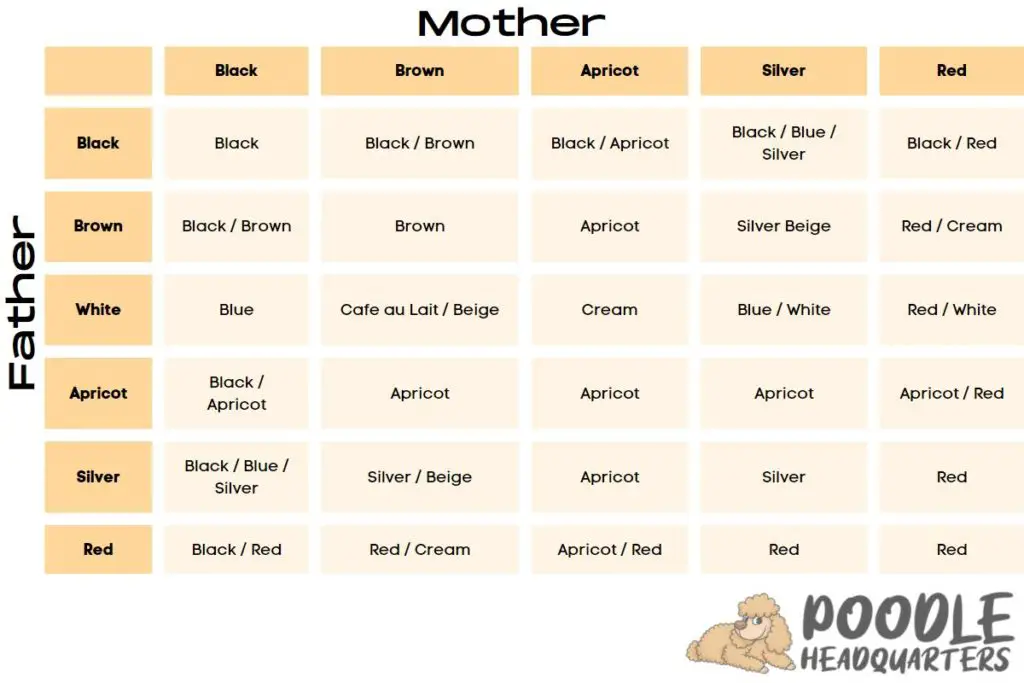Poodles come in over a dozen colors. Owners often choose specific colors, so understanding each is valuable. Color also depends on breeding and age, fading or stabilizing over time.

Black Poodle
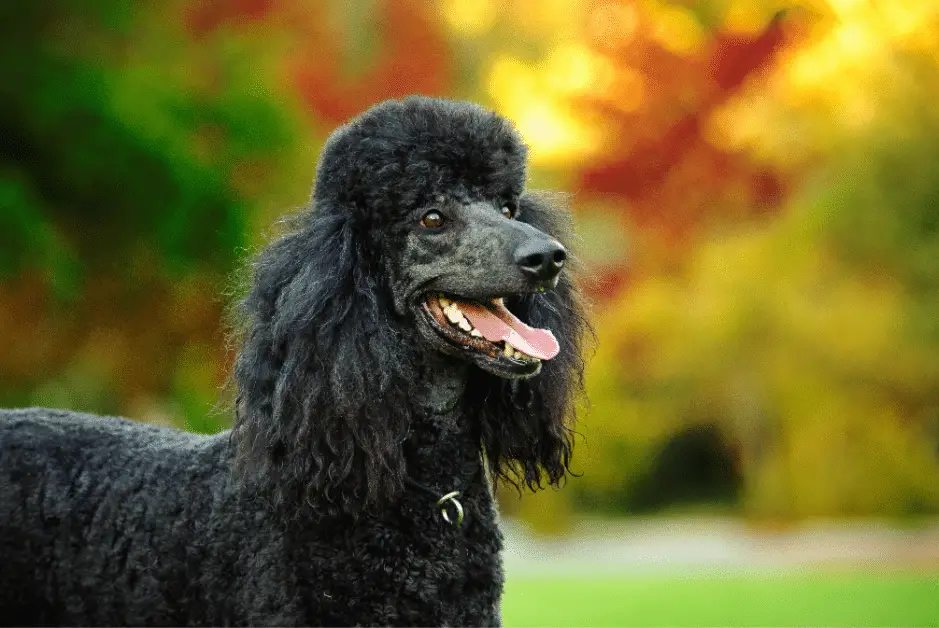
This jet-black color Poodle is a dramatic beauty.
To count as a pure black Poodle, the dog’s coat must look inky black without any blue or silver tints. Black Poodles also don’t have white or silver guard hairs.
Black is a dominant color that comes from three specific enzymes.
The first enzyme, known as a dark eumelanin enzyme, creates a black-colored coat. If your Poodle doesn’t have this initial enzyme present, then she will have the Pheomelanin enzyme that codes for light-colored hair. Finally, accessory enzymes TRP1 and TRP2 carry genes from a Poodle’s mother and father to create a BB genotype that ensures a night-black color.
If the black Poodle should have a shaved face and muzzle, the color should look dead black without any pale undertones. Black Poodles also have all-black points and dark chocolate brown eyes. Unlike some other Poodle hair colors, a real black Poodle’s color won’t fade or change to clear.
Silvers will “clear” during the first year. This means a change of color in the coat of the dog.
This involves the gradual loss of pigmentation from about 90% of the inner coat (the hairs will become transparent or white, depending on thickness), but a substantial percentage of the outer, guard hairs retain some color.
All blue Poodles are born black and then “clear” in 1-2 years. For this reason, many blue Poodles are registered as black. The amount of each color depends on the age of the dog. In middle-aged dogs, medium brown predominates. True blue Poodles will have blue skin pigmentation and most have dark brown eyes.
If a Poodle has one black and one brown gene factor, the genotype is Bb; however black is dominant over brown and the coat would be black. That Poodle, however – if bred- will pass down the Bb gene, which could produce black or brown puppies, depending on which gene the other parent passes down.
Brown Poodle
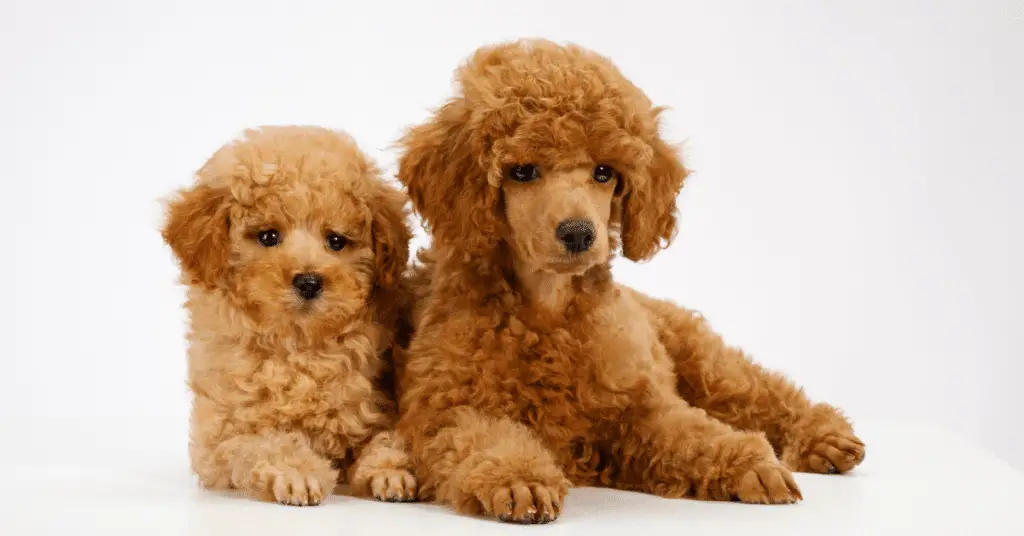
There’s no way that you’re going to confuse a deep brown Poodle with a paler Café Au lait tone.
A good way to tell the difference (other than wildly different shades) is that pure brown Poodles will have liver points offset by dark amber eyes.
Since the brown Poodle’s bb gene is different from the black Poodles’ BB gene, a brown Poodle won’t have any black pigment on its skin, eyes, or body.
In some cases, a dark, chocolaty brown Poodle might change to a lighter Café Au lait shade by the time a dog turns two years old. This isn’t surprising, since Poodles often change to a different coat color by age two. By the time your Poodle reaches three years, its current color usually stabilizes. This doesn’t mean that subtle changes can’t occur due to a dog’s environment or breeding.
Gray Poodle
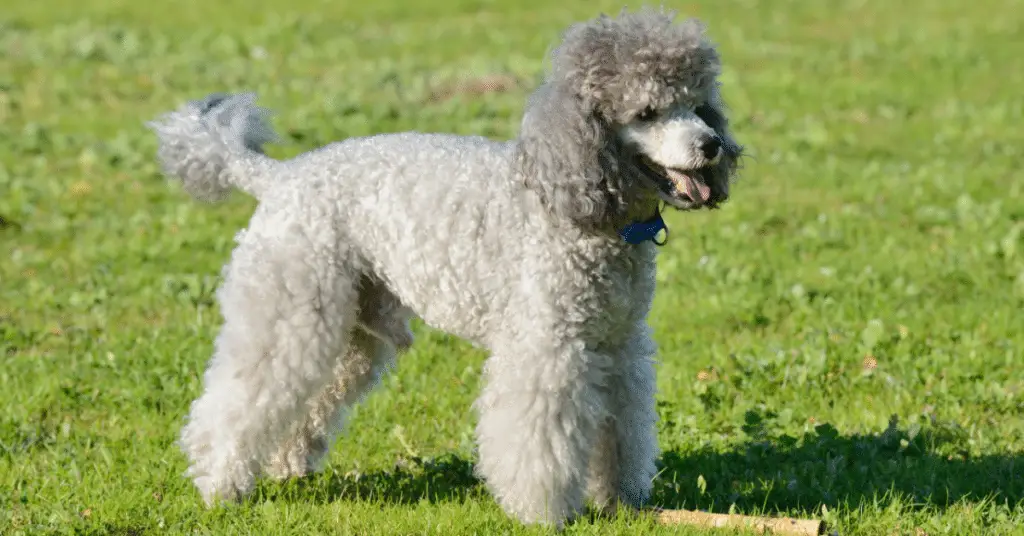
Gray is one of those Poodle colors that a pup can be born with and keep for its entire life. If you have an older Poodle, around 4-5 years old, you might also start to see it turn gray naturally.
Unlike a true black Poodle, many Poodles have a gene called GI locus, or “Progressive Graying”. A mutation in these genes means that an otherwise black, brown, or blue dog’s coat color can fade over time as they mature. If your Poodle has a parent that had Progressive Graying, then your dog has a 50% chance that it will, too.
If your darker dog shares this mutation, you’ll start to notice that it begins to fade in color around 2-3 months old. By the time a dog matures, the process is typically complete, although you might notice minute changes in color as your dog ages.
White Poodle
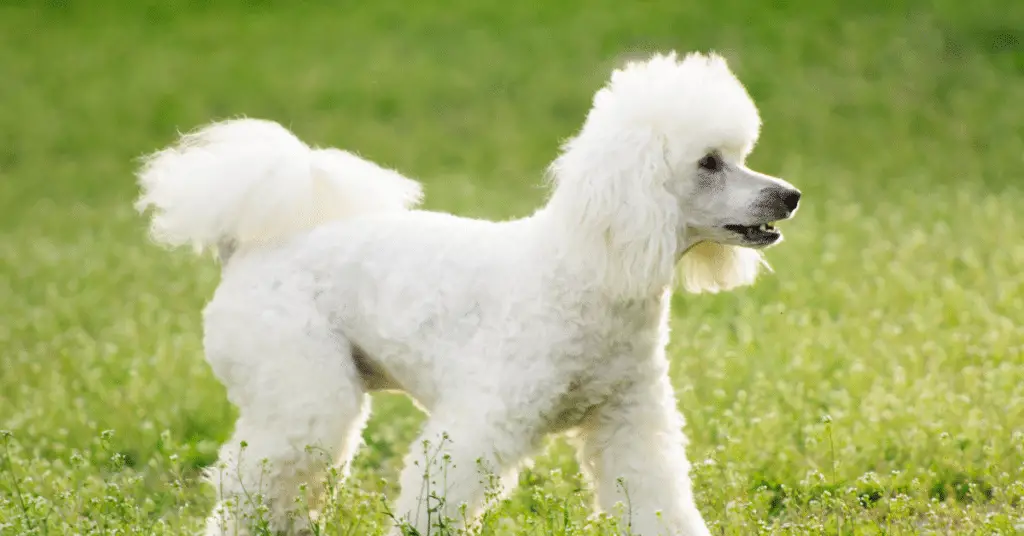
It’s easy to spot a white Poodle with its white coat pure as fresh snow.
If you’re looking for a real white Poodle, make sure to check that it doesn’t have any off-white colorings. While some breeders will try to pass off a white dog that has beige or apricot tints as a white Poodle, this isn’t an acceptable practice.
It’s acceptable for some flecks of black to appear in an otherwise snowflake color coat. What you shouldn’t see in a true white Poodle is ticking. Ticking is a different gene type, a kind of watery gray derived from the silver allele V gene, that gives the coat a dirty look.
If your dog looks like a pristine sheet of paper, then you likely have a true white Poodle.
Blue Poodle

Blue Poodles compete with apricot Poodles for the rarest Poodle coat color in the world.
While uncommon, blue Poodles are generally not as rare as the apricot shade.
Like black Poodles, blue Poodles are born an inky black color. Because their gene doesn’t create color stabilization, these kinds of Poodles gradually fade into a distinctive, smoky blue color with black points and dark brown eyes by two years old.
This process is often referred to as a coat that “clears”. While most puppies experience this change during their first year, some black-born blue Poodles might not “clear” until they are two years old.
A blue Poodle’s outer coat is dark, but you might notice a swirl of colors at the root. Younger dogs will look bluer, while dogs reaching middle age will have a predominantly brown shade at the roots. If you buy a registered black Poodle that is only a few months old or less than two years old, it might not show any indications that it can fade to blue. That’s why many young blue Poodles start out registered as black Poodles.
Café Au Lait Poodle

This color of Poodle is the shade of a perfect cup of coffee and cream. With a smooth blend of cream, apricot, and chocolate, Café Au lait dogs always have liver points with dark amber eye color.
It’s also the standard color for Standard Poodles according to the AKC’s standards.
Since it has a glossy pale tan coat, it’s easy to confuse this Poodle color with a silver beige tint. Many Café Au lait puppies start out dark brown. If you’re trying to identify a café au lait as a puppy, note that they won’t have beige coats since it takes two years for this clear color to appear.
Red Poodle

You might have seen this gorgeous color in films or on TV. This shade is a relative latecomer to the game and didn’t become an official color until 1980.
When red Poodle pups are born, they typically come from a male and female that have apricot lines. This can confuse some people since red is a deeper and stronger color than the paler apricot hue. In fact, red Poodles come from the rare, recessive Rufus gene. This is a gene that allows an apricot or brown-colored coat to fade to a unique red tinge.
According to American standards, a genuine red Poodle has black points.
Points refer to the edges of a Poodle’s body around the eyes, nose, lips, and color on the paw pad. While liver points are recognized, they aren’t preferred in the U. S.
Silver Poodle
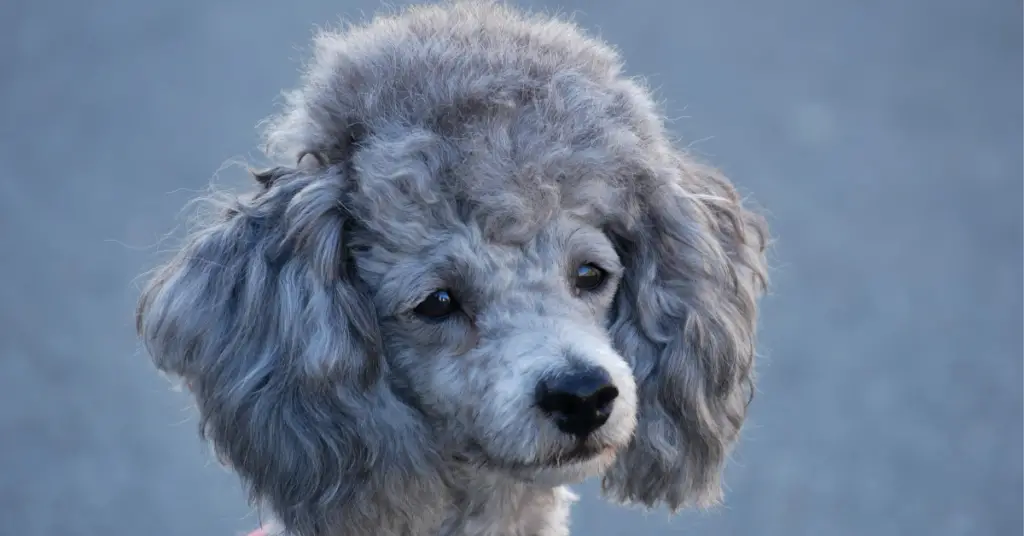
Just like blue Poodles, a genuine silver Poodle is also born black. Similarly, it will “clear” by two years old.
In contrast to blue Poodles, you can identify a true silver Poodle as early as six weeks old. At this time, its face and paws will clear, revealing its silver nature. Its coat can take a year or two to fully fade. With sharp black points and deep brown eyes, silver Poodles look like a diluted grey shade created by the silver allele V gene.
Phantom Poodle
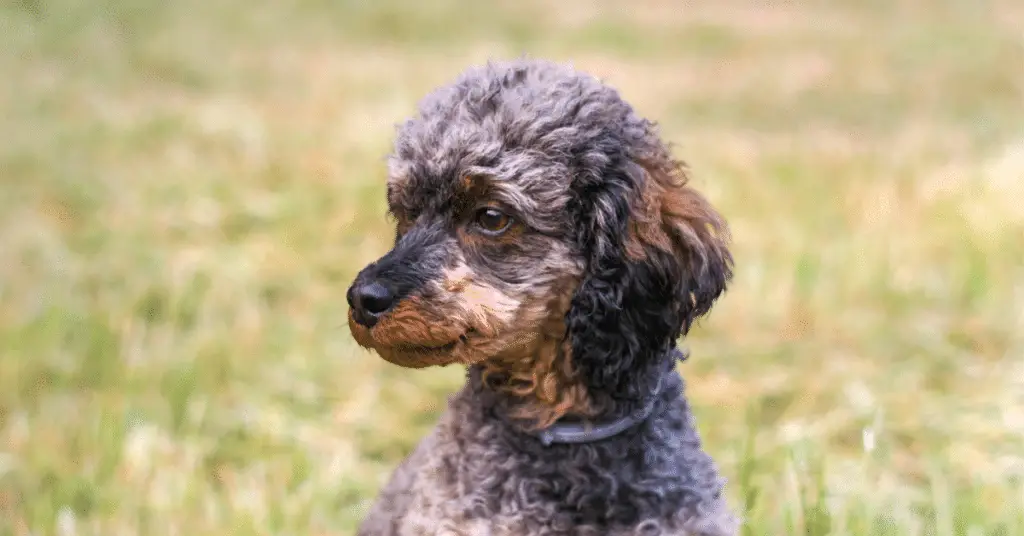
This spookily and adorably gorgeous dog can come in any Poodle size.
In fact, the American Kennel Association does not recognize the phantom Poodle color as a separate Poodle breed. That’s because the phantom Poodle is genetically related to another color, the brindle Poodle.
A phantom Poodle’s background color can range, on an individual dog’s genetics, from black, brown, or silver, to white, apricot, red, or cream. Meanwhile, the Poodle’s points along her eyebrows, jaw, throat, chest, legs, paws, and base of the tail offer a variety of possible combinations.
For instance, a phantom Poodle can have a black coat with apricot points, while a cream dog may present with brown or silver points. Other unique blends include a red coat that shows off apricot points, a brown coat with apricot points, or a silver coat flashed with cream points.
This blend creates a smoky, two-toned phantom look that gives the dog its unusual name.
Parti Poodle
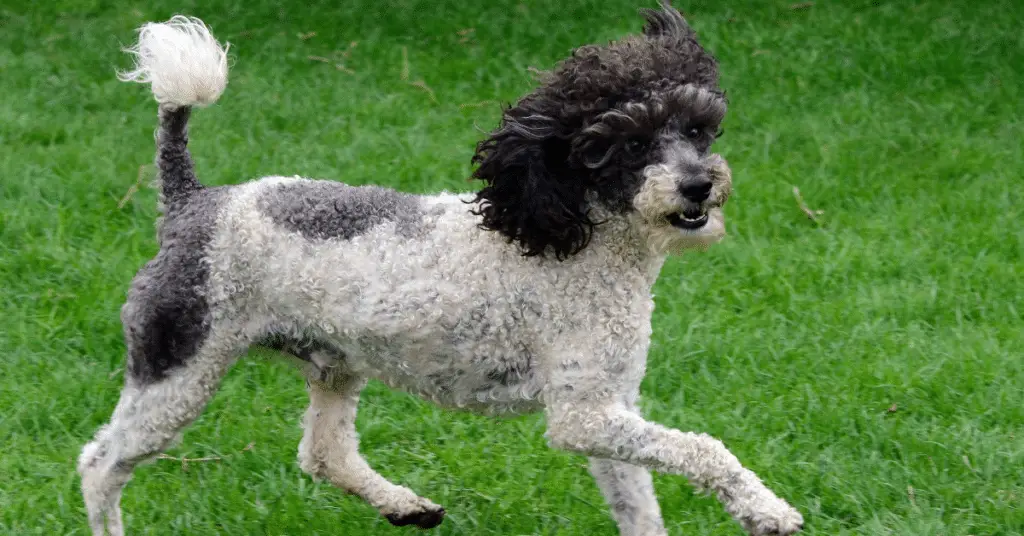
Parti Poodles look like the party animal of the Poodle bunch. Despite the name, these Poodles aren’t any more enthusiastic than their more soberly colored relatives.
In fact, it takes a parti male and female to produce particolored offspring. The MITF gene makes coloring appear in random patches on Standard, Toy, or Miniature Poodles. It’s a recessive gene that means that solid coats are dominant.
A parti Poodle’s coloring looks like a mixed white coat with patches of black, brown, red, or blue hair.
While dogs with brown-shaded coats can have deep amber eyes, they may also have liver-colored noses, rims of eyes, lips, and darker nails. With a riot of color options, part Poodles range from black and blue to white, apricot, gray, cream, silver, beige, red, and Café Au lait shades.
Apricot Poodle

If you’re a fan of rare things, then the apricot Poodle is the unicorn of the Poodle world.
The good news is that apricot Poodles do exist, but this coveted, sunny color can fade fast in UV light. Poodles that spend a lot of time outdoors can quickly lose their signature apricot color and clear to a pale cream color.
According to breed experts, apricot Poodles are produced in rare brown, blue, or possibly white combinations. It’s a gene that is recessive for every color except for white. It’s also the last known color of Poodle since standards had established all the other Poodle colors before the apricot shade appeared.
A true apricot Poodle usually has black points and dark eyes. At the same time, they can also have dark amber eyes with liver eye rims, noses, and lips. According to the AKC, even a vague dark feathering on ears or tail tips is an acceptable color variation even if the coloring isn’t considered ideal.
With a beautiful, gleaming color, apricot Poodles are one of the most coveted Poodle colors.
Sable & Brindle Poodle

Most people haven’t heard of this unusual Poodle color.
While the name sounds like another sleek Poodle color combo, brindle really means sable. The term sable refers to a coat that has one color but has ginger hairs tipped with a black tint. Meanwhile, this Poodle will have black or occasionally dark gray hair on the ears, behind the legs, and along the tail.
If you shave a brindle Poodle, you’ll get a tiger-striped color blend. Meanwhile, a sable coat has a more solid color when shaved. These Poodle pups are born with dark brown coats. Early on, it’s easy to mistake sable & brindle Poodle pups for apricot Poodles dusted with powdery black. By the time a Poodle grows up, this black-tipped sable look can fade out entirely.
Cream Poodle

Want to know how to tell a cream Poodle from its beige or Café Au lait cousins? Check out his nose. If your Poodle has a black nose and black points, then it has the Cch gene. This gene ensures that a brown Poodle turns into a creamy color.
This Poodle is one of the easiest Poodle colors to identify. That’s because most Poodles with light coats have liver-colored noses rather than black noses.
A cream Poodle is one of the rarest Poodle colors. Cream is a recessive gene that requires special breeding to get the creamy color with the required black points. Because both white and cream Poodles have black points, you’ll want to pay close attention to pale cream colors that can look white in certain lights.
Frequently Asked Questions
What Is the Rarest Poodle Color
Apricot Poodles are the ones that have the rarest color of them all, thanks to their recessive gene.
What Is The Most Expensive Poodle Color
The most expensive poodle color is apricot due to its extreme rarity in the breed.
What Poodle Colors Are Dominant
A Poodle may carry genes for other colors besides the one on its coat. Some of these are dominant, while others are recessive. The genes of a solid color coat are always the dominant ones.
